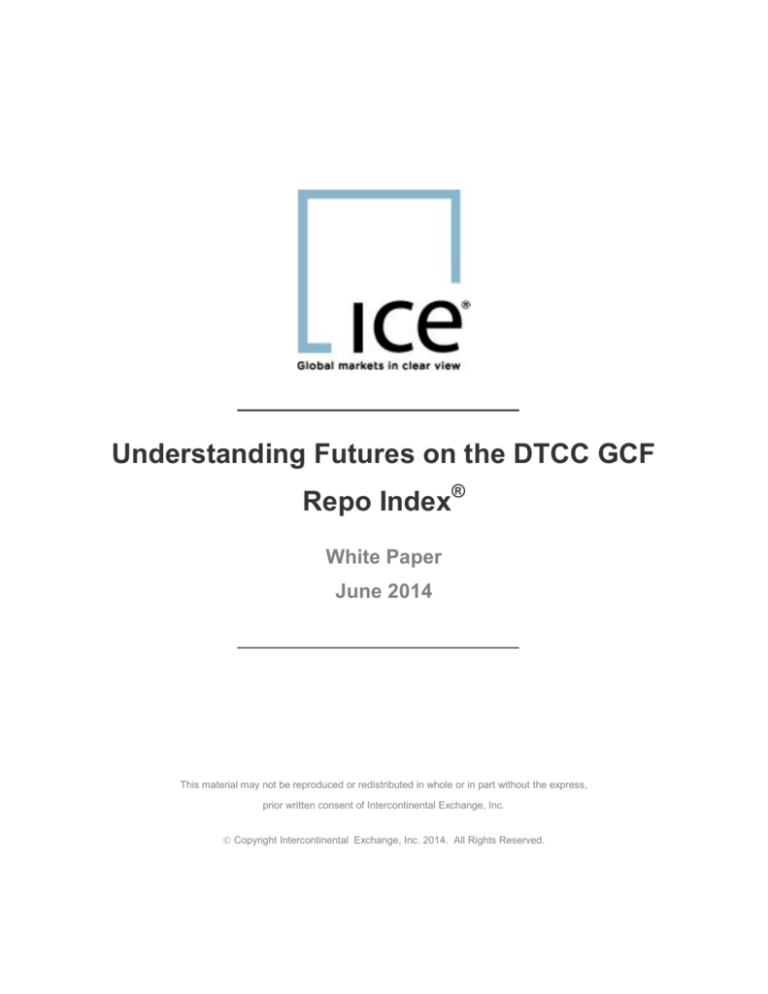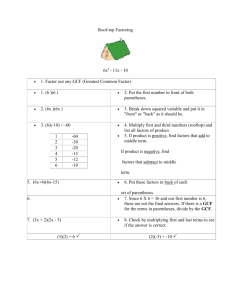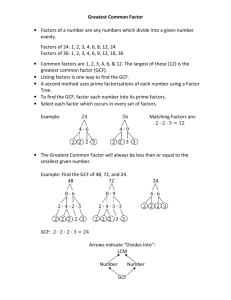
Understanding Futures on the DTCC GCF
Repo Index®
White Paper
June 2014
This material may not be reproduced or redistributed in whole or in part without the express,
prior written consent of Intercontinental Exchange, Inc.
Copyright Intercontinental Exchange, Inc. 2014. All Rights Reserved.
Understanding Futures on the DTCC GCF Repo Index®: White Paper
Table of Contents
INTRODUCTION .................................................................................................................................3
PRICING AND QUOTATION .................................................................................................................3
MEASURING RISK ...............................................................................................................................4
HEDGING SHORT-TERM RATE EXPOSURE ............................................................................................4
SPREAD STRATEGIES ..........................................................................................................................6
INTRAMARKET SPREADS ........................................................................................................................... 7
INTERMARKET SPREADS ........................................................................................................................... 7
OVERNIGHT INDEX SWAPS .................................................................................................................8
HEDGING OIS .....................................................................................................................................9
U.S. FEDERAL RESERVE MONETARY POLICY....................................................................................... 10
CONCLUSION ................................................................................................................................... 10
APPENDIX ........................................................................................................................................ 11
Table 1 – U.S. Treasury DTCC GCF Repo Index® Contract Specifications................................................ 11
Table 2 – Bloomberg, usTA Commodity, Futures Contract Table ........................................................... 11
Understanding Futures on the DTCC GCF Repo Index®: White Paper
INTRODUCTION
ICE DTCC GCF Repo Index® Futures (“GCF Futures”) have achieved remarkable growth since their
launch in July 2012. These products have been embraced by various market participants throughout the
industry in the short time since their introduction. The contracts are designed to help trading desks better
manage interest rate exposure by using a flexible, liquid, transparent, cost effective and centrally cleared
instrument.
The DTCC GCF Repo Index® is the first and only benchmark designed to track the average daily interest
rates paid for overnight General Collateral Finance repurchase agreements (“GCF Repo®”) on U.S.
Treasury, Agency and Mortgage- Backed securities. These indices provide a transparent and
comprehensive view of the overnight repo trading activity netted each day and settled as part of the
clearing process for all U.S. government securities trades.
GCF Repo® transactions are fully executed and cleared exclusively through the Fixed Income Clearing
Corporation (FICC), a subsidiary of the Depository Trust & Clearing Corporation (DTCC). DTCC created
the DTCC GCF Repo Index® in 2010 to improve transparency and liquidity in the U.S. funding markets.
This paper is intended to provide an understanding of GCF Futures mechanics and some of the methods
employed by the industry to achieve hedging and arbitrage results through their use.
PRICING AND QUOTATION
GCF Futures are based on interest on the relevant DTCC GCF Repo® asset class having a face value of
$5,000,000 for one month calculated on a 30-day basis at a rate equal to the average relevant DTCC
GCF Repo Index® rate for the contract month. Expiring contracts are cash settled against the
corresponding average daily DTCC GCF Repo Index® rate for the delivery month, rounded to the nearest
one-hundredth of one basis point. Final settlement occurs on the last trading day of the delivery month.
The corresponding daily DTCC GCF Repo® overnight rate is calculated and reported by The Depository
Trust & Clearing Corporation. The exchange offers “serial” contract months extending out 2 years (24
months total) into the future. See Appendix – Table 1, for contract specifications.
These contracts are quoted using the “IMM index” Convention. The IMM index is equal to 100 minus the
implied corresponding average daily DTCC GCF Repo Index® rate for the delivery month.
IMM Index = 100.00 – Monthly Average Rate
E.g., if the monthly average DTCC GCF Repo Index® rate equals 0.250%, the IMM index is quoted as
99.750.
IMM Index = 100.00 – 0.250 = 99.750
If the value of the futures contract should fluctuate by one basis point (0.01%), this equates to a $41.67
movement in the contract value. This may be confirmed by calculating the basis point value (BPV) of a $5
million face value, 30-day money market instrument into the following formula.
Basis Point Value = Face Value x {days/360} x 0.01% = $5,000,000 x {30/360} x 0.01% = $41.67
The minimum allowable price fluctuation, or “tick” size, is one-half of one basis point, or 0.005% for all
deferred monthly contracts. Based on a $5 million face-value 30-day instrument, this equates to $20.835.
For the front or expiring contract month, the minimum price fluctuation is set at one-quarter basis point, or
0.0025%, equating to $10.4175 per contract.
E.g., See Appendix – Table 2, trade date January 18, 2013, USTH3 (futures on us Treasury DTCC GCF
Repo Index® March 2013) expiration advanced by 2.5 basis points to settle the day at a price of 99.83.
With each basis point valued at $41.67 based on a $5 million 30-day instrument, this implies an increase
in value of $104.175 for the day per contract.
MEASURING RISK
Basis Point Value (BPV) is the reference for measuring risk in the context of short-term, non-coupon
bearing instruments, i.e., money market instruments such as Repurchase Agreements, Eurodollars,
Treasury Bills, etc.
It measures the expected monetary change in the price of a money market instrument given a 1 basis
point (0.01%) change in yield. It returns a dollars and cents valuation based upon the specific face value
of the instrument which is referred to as the “dollar value of an 01” or “DV01.”
BPV is calculated based on the face value and number of days until maturity of the referenced money
market instrument as follows:
BPV = Face Value x {Days/360} x 0.01%
HEDGING SHORT-TERM RATE EXPOSURE
Risk management programs at financial institutions use futures to hedge against the possibility of rising or
declining rates. These programs are designed to offset the change (delta) in risk exposures to be hedged,
with an offsetting change (delta) in the value of a futures contract.
By using the BPV formulae and the fixed one basis point change (BPV) in yield for the Futures on the
DTCC GCF Repo Index® we can determine the number of futures contracts necessary to hedge such
risk.
BPV risk ÷ BPV futures = Hedge
E.g., a financial institution borrows $100 million to finance a purchase and chooses to lock in the financing
for 30 days. The institution is exposed to paying a higher interest rate if rates decline over this time frame.
BPV risk = $100,000,000 x {30/360} x 0.01% = $833.33
BPV future = $5,000,000 x {30/360} x 0.01% = $41.67
$833.33 ÷ $41.67 = 20
Purchasing 20 futures contracts will hedge the risk of declining interest rates. Let us apply an interest rate
to the above example and prove the hedge equation –
$100 million borrowed at 1.50% for 30 days. Futures contract price is 98.5 (100 – 1.50). Average
financing for the month decreased by 25 BP. Futures contract priced at 98.75 (100 – 1.25).
BVP risk or “DV01” = $833.33
$833.33 x 25 = $20833.25 ”loss”
BVP futures or “DV01” = $41.67
$41.67 x 25 x 20 = $20835 “gain” (difference is from penny rounding of futures contract)
Inversely, the institutional lender in the above example is exposed to receiving a lower interest rate if
rates increase within this time frame and should sell 20 contracts to mitigate the risk.
Hedge risk of rising interest rates > Sell futures
Hedge risk of declining interest rates > Buy futures
Let us consider the implications of a longer term loan.
E.g., a financial institution borrows $100 million to finance a purchase on July 1st and chooses to lock in
the financing for 180 days at a rate of 1.50%.
BPV risk = $100,000,000 x {180/360} x 0.01% = $5000
BPV future = $5,000,000 x {30/360} x 0.01% = $41.67
$5000 ÷ $41.67 = 120
The financial institution would need to purchase 120 futures contracts to hedge the risk of declining
interest rates.
But where should the hedge be placed? The front month of the loan - Buy 120 July contracts? The last
deferred month of the loan – Buy 120 December contracts? These are examples of “stacking” – let us
review the results.
E.g., Rates decline 25Bp on Oct 1.
BVP risk or “DV01” = $5000
$5000 x 25 = $125,000 “loss” BVP futures or “DV01” = $41.67
$41.67 x 25 x 120 = $125,010 “gain” (difference is from penny rounding of futures contract)
If you buy 120 July contracts and interest rates decline any time after the July contracts expire, you are
exposed/do not have a hedge.
The most effective way to hedge a term loan is through a “strip” transaction – i.e. to execute consecutive
monthly contracts for the duration of the loan period that matches the months’ risk. In this example, one
would purchase 120 DV01 contracts divided by the number of months of the underlying loan, 6, or 20
contracts each month.
If you buy 120 December contracts and interest rates decline any time before December, you are over
hedged as each contract month expires.
SPREAD STRATEGIES
A future spread trade is the simultaneous purchase and sale of two different futures contracts with the
design of profiting from the change in relationship in price between the two contracts. In general, spreads
have lower margin requirements than outrights of the same contract which acknowledges the lower risk in
trading a spread. There are two types of spreads – Intramarket and Intermarket.
INTRAMARKET SPREADS
Intramarket spreads are created as calendar spreads. You are long and short futures in the same market,
but in different months.
E.g.- Buy (long) 10 usTN3 (July 2013) @ 99.90 and sell (short) 10 usTQ3 (August 2013)@ 99.885.
(“UST” is the Bloomberg system reference for ICE U.S. Treasury DTCC GCF Repo Index® futures. N and
Q are the standard industry codes for the months of July and August. 3 is the standard reference code for
the contract year)
USTN3 increases to 99.91, USTQ3 increases to 99.89.
BVP futures or “DV01” = $41.67
USTN3: 99.91 – 99.90 = .01. 10 x $41.67 = $416.70 profit.
USTQ3: 99.89 – 99.885 = .005. 10 x $20.835 = $208.35 loss.
$416.70 – $208.35 = $208.35. Net profit.
USTN3 increases to 99.905, USTQ3 increases to 99.895.
BVP futures or “DV01” = $41.67
USTN3: 99.905 – 99.90 = .005. 10 x $20.835 = $208.35 profit.
USTQ3: 99.895 – 99.885 = .01. 10 x $41.67 = $416.70 loss.
$416.70 – $208.35 = $208.35. Net loss.
INTERMARKET SPREADS
Intermarket spreads can be accomplished by going long or short futures in one market, and short or long
futures of the same month in another market.
E.g., Buy (long) 60 USTU3 (US Treasury DTCC GCF Repo Index® future September 2013) @ 99.88 and
sell (short) 100 LEDU3 (Eurodollar September 2013) @ 99.69.
USTU3 increases to 99.89, LEDU3 increases to 99.695.
BVP futures or “DV01” = $41.67 GCF Futures
BVP futures or “DV01” = $25.00 (ED)
Inter-commodity ratio: $25 ÷ $41.67 = 0.60
B/S 6 GCF Futures ~ S/B 10 ED
USTU3: 99.89 – 99.88 = .01. 60 x $41.67 = $2500.20 profit.
LEDU3: 99.695 – 99.69 = .005. 100 x $12.50 = $1250 loss.
$2500.20 – $1250 = $1250.20.Net profit.
USTU3 increases to 99.885, LEDU3 increases to 99.70.
BVP futures or “DV01” = $41.67 GCF Futures
BVP futures or “DV01” = $25.00 (ED)
Inter-commodity ratio: $25 ÷ $41.67 = 0.60
B/S 6 GCF Futures ~ S/B 10 ED
USTU3: 99.885 – 99.88 = .005. 60 x $20.835 = $1250.10 profit.
LEDU3: 99.70 – 99.69 = .01. 100 x $25.00 = $2500 loss.
$2500.00 – $1250.10 = $1249.90.Net loss.
OVERNIGHT INDEX SWAPS
An overnight index swap is a financial transaction where one party receives a periodic fixed payment
referencing a formula which represents the compounded reference overnight interest rate for the given
period. An OIS allows a market participant to exactly hedge their funding exposure into a fixed rate. The
fixed rate payer/ floating rate receiver is called the Payer and the fixed rate receiver/floating rate payer is
called the Receiver. There is usually one settlement of net cash flows at the maturity of the deal. The
settlement amount is the net of the amount that is accrued on the fixed leg (simple interest calculation)
and the amount that is accrued on the floating leg (a daily compounded rate of the variable rate).
The floating rate calculus can be expressed as follows:
FR = ER x nd/basis
FR = Floating Rate
ER=Effective Rate or = return on overnight rate rollovers or =
(1+R1*1/basis)(1+R2*1/basis)(1+R3*1/basis)…..-1
R1 = day 1 overnight reference rate, R2 = day 2 overnight reference rate, etc.
nd = number of days of the swap
basis = day count convention
E.g., a bank enters into the following swap agreement:
Tenor: 1 Week (7 days), Notional: $100,000,000, Bank pays: Fixed rate of 0.15%, Bank receives: daily
compounded DTCC GCF Repo Index® average, settlement: at maturity. Day convention:360
DTCC GCF Repo Index® rates recorded that week – Monday 0.161, Tuesday 0.143, Wednesday 0.147,
Thursday 0.152, Friday 0.138.
FR = (1+0.00161x1/360)x(1+0.00143x1/360)x(1+0.00147x1/360)x(1+0.00152x1/360)
x(1+0.00138x3/360-1)x360/7
FR = (1.00002825 – 1)x360/7
FR = 0.0014529 or 0.145% Rounded
Final payment = $100,000,000 x ( 0.15% - 0.145%)x 7/365
Bank pays = $91.63
HEDGING OIS
When an Overnight Index swap is priced by referencing the DTCC GCF Repo Index® they may also be
hedged with futures contracts referencing the same index.
Fixed rate payers (floating rate receivers) are exposed to the risk of falling rates and rising prices and
would buy Futures on the DTCC GCF Repo Index® as a hedging strategy. Similarly, fixed rate receivers
(floating rate payers) are exposed to the risk of rising rates and falling prices and would sell Futures on
the DTCC GCF Repo Index® as a hedging strategy.
Fixed rate payers hedge risk of falling rates > Buy futures
Fixed rate receivers hedge risk of rising rates > Sell futures
U.S. FEDERAL RESERVE MONETARY POLICY
Traditionally, the Federal Reserve targeted the federal funds rate as a transmission mechanism for its
monetary policy stance across the interest rate curve. Post 2008 financial crisis, the Federal Reserve has
highlighted that the federal funds rate may not be the best indicator of short term interest rates. The
1
recent FOMC meeting minutes released in May 2013 “raised the possibility that the federal funds rate
might not, in the future, be the best indicator of the general level of short-term interest rates, and
supported further staff study of potential alternative approaches to implementing monetary policy”, and a
2
Federal Reserve staff white paper concludes that, with the federal funds market hypothetically becoming
less relevant with the inception of Basel 3 (LCR), a target “general collateral repo rate” can prove to be a
more effective policy tool because of the broader set of repo market participants than federal funds limited
depository institutions and GSE participants. In a follow up to these statements and indicative of the roll
that a Repo index may have in the implementation of monetary policy, the minutes of the July 2013
3
FOMC meeting offered the following - “In support of the Committee’s longer-run planning for
improvements in the implementation of monetary policy, the Desk report also included a briefing on the
potential for establishing a fixed- rate, full-allotment overnight reverse repurchase agreement facility as an
additional tool for managing money market interest rates. The presentation suggested that such a facility
would allow the Committee to offer an overnight, risk- free instrument directly to a relatively wide range of
market participants, perhaps complementing the payment of interest on excess reserves held by banks
and thereby improving the Committee’s ability to keep short-term market rates at levels that it deems
appropriate to achieve its macroeconomic objectives.”
Though the future method for transmission of monetary policy stance remains unknown at this time given
the current questionable relevance of the Fed Funds rate, the GCF Futures reference curve has become
a leading indicator for shifts in short term interest rates. As the Federal Reserve begins to remove its
extraordinary monetary intervention, traders can use the futures to express opinions about shifts in
Federal Reserve interest rate policy. The perceived change in interest rates will reflect in the deferred
months of the futures on the DTCC GCF Repo Index® contract strip.
CONCLUSION
GCF Futures have become an essential tool for institutional market participants to hedge their short term
interest rate risk. Equally, as discussed above, they offer tremendous utility for arbitrage activity and
expressing interest rate opinions. To learn more about this product, visit:
https://www.theice.com/productguide/ProductSpec.shtml?specId=31500931
1. “Minutes of the Federal Open Market Committee April 30-May 1, 2013”
http://www.federalreserve.gov/monetarypolicy/files/fomcminutes20130501.pdf
2. “Is a target repo rate a viable alternative to the target federal funds rate?” Klee and stebunovs, September 2011
3. “Minutes of the Federal Open Market Committee July 30-31, 2013”
http://www.federalreserve.gov/monetarypolicy/files/fomcminutes20130731.pdf
APPENDIX
Table 1 – U.S. Treasury DTCC GCF Repo Index® Contract Specifications
Table 2 – Bloomberg, usTA Commodity, Futures Contract Table









